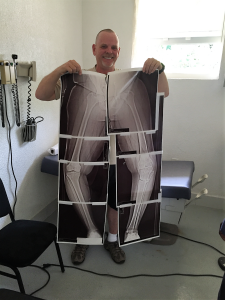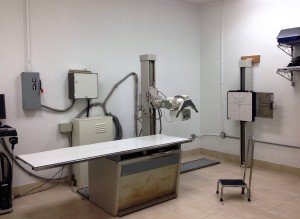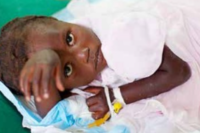By Peter DeGraaf, Admin. Director, Radiology, Holy Name Medical Center
The Plan
Four years ago, I arrived at Hôpital Sacré Coeur armed with good intentions and a strong hope to help improve the radiology services at this important hospital located in Milot, Haiti. I was looking forward to this adventure and challenge. Being in Radiology Administration for many years, I was excited to get back to the hands-on aspects of Radiology and the opportunity to teach the skills I had learned to the Haitian Technologists. Even my staff back at Holy Name Medical Center (HNMC) joked that the Boss was going back to working for a change.
The Radiology staff consisted of two Technologists and one aide. Well dressed in neat and clean business casual attire; they were polite and professional. Yet, in observing them do their jobs, I noticed a lack of connection with their patients. I could tell they knew the basics of performing radiology exams, but there was a definite disconnect between the caregivers and those that needed the care. There was little human interaction at all. Examination directions largely consisted of pointing and gesturing with little verbal communication. They were trying to do their job as best they could under the circumstances, but the volume of patients as well as the problems with the physical plant and the equipment left them little time for anything but the basics.
The Challenge
The Radiology Suite at Sacré Coeur was a sad sight. It consisted of a large room containing one General Diagnostic X-ray (GDX) machine approximately 40 years old with rusted parts, broken locks and a floating tabletop that no longer functioned. Several of the wires had been cut and spliced back together using ordinary orange extension cords. A smaller side room contained a second GDX machine that was not connected to anything and did not function at all, but looked to be in pretty good condition. The darkroom contained chemical tanks with no covers on them that reeked of a strong ammonia smell, which is caused by cross contamination of chemicals, due to the total lack of ventilation fans. The automatic processor had not been cleaned since installation and I was informed that it was just filled with chemicals whenever it ran dry. The films they were using were past their expiration date, consisting of several different speeds and color bases. The chemicals being used to develop the films were also expired. The roof was leaking and I could see the sky in certain places. The doors to the outside waiting area were made of wood with no lead and had been eaten by termites to the extent that you could see through them. There was no changing area for patient privacy and no patient gowns to be found.
A Most Unusual Sign of Hope
I could easily go on and on describing all the issues laying before me. I could have easily turned and walked away from it all. I could have easily stated that this is beyond fixing and returned home. With all these options running around in my head; it was about that time that I looked up to the ceiling inside the main X-ray room and I began to smile because what I saw gave me the hope I needed. Up where there should have been steel I-beams holding up the X-ray Tube column were RAILROAD TRACKS! They had used railroad tracks to put together the machine.
At that moment, I knew that I had everything I needed to turn this place around. I had a staff that was trying to maintain their professionalism despite the shortcomings of their surroundings and I was going to be working with a group of people who knew HOW TO DO MORE WITH WHATEVER THEY HAD! I would be working with a crew that used railroad tracks because that was all they had.
The Solution
The solution was simple in statement. Fix the problems with the rooms and equipment. Get the proper tools needed to get the job done. Convince and teach the Technologists that the most important aspect of their job was the care of the patient. The first part was challenging, but through the generosity of various vendors and patrons, we got that part taken care of. The second part was a bit more difficult: in the past radiology experts would make one or two visits to the Sacré Coeur and then never be seen again so the Haitian technologists had little expectation of long term commitment from me or my staff. Thanks to a very dedicated and passionate group of Technologists from Holy Name Medical Center, we slowly earned their trust and friendship.
Besides visiting and teaching at least 6 times a year over the past 4 years; emails have been exchanged and Skype calls are a normal event. My staff has shown them that we are not going away and has made them part of our family. Is everything perfect… No, but we have come a long way in a relatively short time.
Flash forward fours year to today. There is a beautiful new Radiology suite at HSC — without railroad tracks though. It has metal doors, lead glass, physicist approved walls, a changing area with gowns. The lead aprons are new and fully inspected, positioning aides are available, textbooks have been purchased and the staff now has radiation monitoring badges. HSC now uses digital CR imaging and only prints images for outside clinics. When that is required, they use laser printing on paper. Otherwise the images are viewed on the various computers stationed throughout the hospital. If any issues arise, the communication between HSC staff & HNMC staff is just an email or Skype away. HNMC bio-medical has gotten involved and now has electronic connections with HSC staff when it comes to doing repairs and maintenance on the equipment.
We gave them the tools to get the job done, but the passion for success came from within them and continues to grow every day. HSC & HNMC Radiology are now one force working together for the long haul.
Success that Puts Patients First
 Patient care has improved beyond my wildest imagination. Privacy and personal dignity is now a priority. The Haitian Technologists are now engaged with patients and give instructions with respect and concern. While the patients are still in awe of the advanced electronics, they now enjoy being able to see the images appear in seconds. Having been involved from the beginning, I am truly amazed at the progress the Technologists have made.
Patient care has improved beyond my wildest imagination. Privacy and personal dignity is now a priority. The Haitian Technologists are now engaged with patients and give instructions with respect and concern. While the patients are still in awe of the advanced electronics, they now enjoy being able to see the images appear in seconds. Having been involved from the beginning, I am truly amazed at the progress the Technologists have made.
The personal connection between HSC Radiology and HNMC Radiology is what made all the difference. They (HSC Staff) truly believe we are in this struggle together and not just visitors for a week. They believe in our long-term commitment and they know we will always be there whenever they need us.
Care to join the journey?










